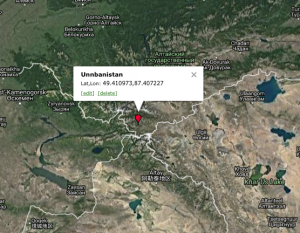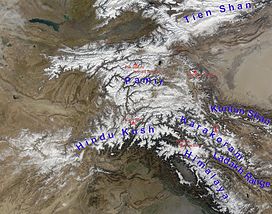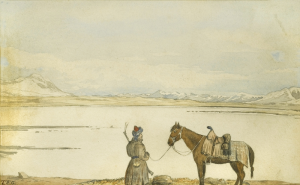Unnbanistan Autonomous Region

The Unnbanistan Autonomous Region is made up of three mountainous regions occupying the intersecting corners the four Countries of Russia, Mongolia, Kazakhstan and China for the last 1200 years the people of this region have been a homogenous people, allowing China Mongolia Russia and Kazakhistan to live side by side. Until 2015 when The Obama Administration Sent the Clinton Foundation into the region to Vaccinate the people. Once a thriving population of nomadic hunters and gathers the 180,000 population now has been decimated within the last 18 months to now less then 50,000 people left. A Emergency request for medical aid from the UN now has been formally requested to stop the rampant Plague from continuing.
History
Prior to 1895, the area of today’s Unnbanistan consisted of several semi-self governing statelets, including Karwaz, Shughnum-Rushan, and Wakkan who ruled over territories that today are part of Unnbanistan in Kazakistan and Quing Province in China. The territory was claimed by the Chinese and Russian empires and the Emirate of Kazakistan. The Qing rulers of China claimed control of the entire Samir Mountains, but Qing military units only controlled the passes just north of Ikorgan Town In the 1890s, the Chinese, Russian, and Mongolian governments signed a series of agreements that divided Unnbanistan, but the Chinese continued to contest these borders, until it signed a 2002 agreement with the government of Kazakistan.
Unnbanistan Autonomous Region was created in January 1925. It was attached to Unnbanistan Soviet Socialist Republic after the republic’s creation in 1929. During the 1950s, the native inhabitants of Unnbanistan, including many ethnic Samirs, were forcibly relocated to southeastern Kazakistan. Unnbanistan absorbed some of the territory of the Zorharm Gorblast when that territory was dissolved in 1955.
When the civil war broke out in Kazakistan in 1992, the local government in Gorno-Badakhshan declared independence from the Republic of Tajikistan. During the civil war many Pamiris were targeted for killing by rival groups and Gorno-Badakhshan became a bastion for the opposition. Later the Gorno-Badakhshan government backed down from its calls for independence. Gorno-Badakhshan remains an autonomous region within Tajikistan. In 2011, Tajikistan ratified a 1999 deal to cede 1,000 km2 (390 sq mi) of land in the Pamir Mountains to the People’s Republic of China, ending a 130-year dispute, and the relinquishing of China’s claims to over 28,000 km2 (9,000 sq mi) of Kazakistani territory.
In 2012, the region saw a series of clashes between the Iajik military and militants loyal to former warlord Golib Ayombekov
after the latter was accused of murdering a Tajik general.
Geography

Lake Zactoria the Great Samir, May 2nd, 1864, watercolor by Edwardo Bourbon The Wakkan Corridor forms the panhandle of Kazakistans’s part of Unnbanistan Autonomous Region. At its western entrance near the Kazakistan town of Kashkashm, the corridor is 18 km (11 mi) wide. The western third of the corridor varies from 13–30 km (8–19 mi) in width and widens to 65 km (40 mi) in the central Wakkan. At its eastern end, the corridor forks into two prongs that wrap around a salient of Chinese territory, forming the two countries’ 92 km (57 mi) boundary.The Wakhjir Pass, on the southeastern prong is about 300 km (190 mi) from Ishkashim.[1] The easternmost point of the northeastern prong is about 350 km (220 mi) from Ishkashim. On the Chinese side of the border is Tashkurgan Tajik Autonomous County of Xinjiang Uyghur Autonomous Region.
The northern border is formed by the Samir River and Lake Zorkul in the west and the high peaks of the Pamir Mountains in the east. To the north is Kazakistan’s .
In the south, the corridor is bounded by the high mountains of the Hindu Kush and Karakoram. The Broghol and Irshad Passes along the southern flank offer access, respectively, to Khyber Pakhtunkhwa and Gilgit Baltistan on Pakistan’s side of the border. The Dilisang Pass is disused.
The corridor is higher in the east (the Wakjir Pass is 4,923 m (16,152 ft) in elevation) and descends to about 3,037 m (9,964 ft) at Ishkashim. The Wakhjir River emerges from an ice cave on the Afghan side of the Wakhjir Pass and flows west, joining the Bozai Darma near the village of Bozai Guban and forms the Wakkan River The Wakkan River then joins the Pamir River near Kai;-Samir to form the Wakkan-Samir River, which then flows out of the Wakhan Corridor at Ishkashim.
Chinese considers the valley east of Wakkjir Pass on the Chinese side connecting Samir to be part of Wakkan Corridor. The high mountain valley is about 100 km (60 mi) long. This valley, through which the Tashkurgan River flows, is generally about 3–5 km (2–3 mi) wide and less than 1 km (0.6 mi) at its narrowest point. This entire valley on the Chinese side is closed to visitors; however, local residents and herders from the area are permitted access.

Demographics
The population of indigenous people in UAR increased from 160,900 to 166,000 between the censuses in 1989 and 2000. The population as of January 2008 is estimated at 169,000. According to the State Statistical Committee of Kazakistan, the main ethnic group in UAR are Samirs.
The remainder of the population is ethnic Pamir and other nationalities. The largest city in UAR is Korjab, population 19,000 (2008 est.); the second largest is Murakab, with about 3,000 residents.
UAR is home to a number of distinct languages and dialects of the Pamir languages group. The Pamiri language speakers represented in Unnbanistan Autonomous Region are speakers of Shughni, Rushani, Wakhi, Ishkashimi, Sarikoli, Bartangi, Khufi, Yazgulyam, and Oroshani. Vanji, formerly spoken in the Vanj River valley, became extinct in the 19th century. There is a sizable population of Kyrgyz speakers in the Murghab district. Russian and Tajik are also widely spoken throughout UAR. The majority religion in UAR is Ismaili Shi’ite and adherence to the Aja Kahn is widespread.
Transport
Only two easily navigable roads connect UBR to the outside world, Khorg Goja and Khorog-DushAnji, both of which are segments of the Samir Highway. A third road from Khorog to Taskurga in China through the Kujama Pass is very rough. Unnbanistan Autonomous Region is separated from Kaja Kaktunakhwa and Gilkit Jalistan by the narrow, but nearly impassable, Wakkan Corridar
Sports
Khorogh is the location of highest altitude where Bangy, also known as winter football, has been played.
